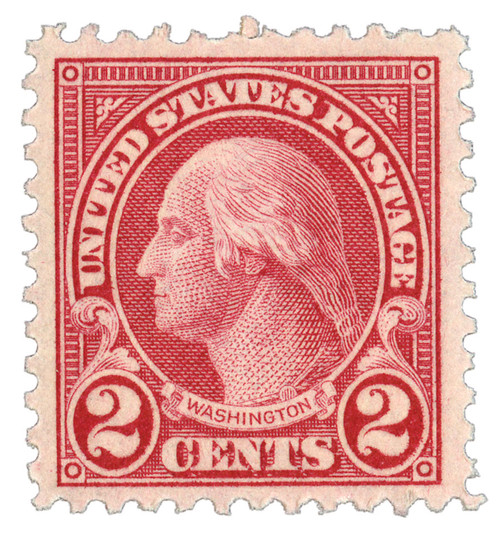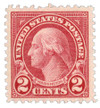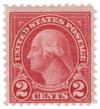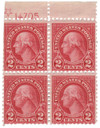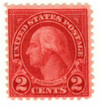
1923 2c Washington, carmine, perf 11
# 595 - 1923 2c Washington, carmine, perf 11
$295.00 - $1,800.00
U.S. #595
Series of 1923-26 2¢ George Washington
Series of 1923-26 2¢ George Washington
Issue Date: June 25, 1923
First City: Washington, D.C.
Quantity Issued: Unknown
Printed by: Bureau of Engraving and Printing
Printing Method: Rotary Press
Perforation: 11
Color: Carmine
First City: Washington, D.C.
Quantity Issued: Unknown
Printed by: Bureau of Engraving and Printing
Printing Method: Rotary Press
Perforation: 11
Color: Carmine
It’s estimated that only about 100,000 U.S. #595 stamps were issued. Early coil waste stamps had already been perforated, but U.S. #595 had to be run through the perforating machine twice, receiving 11-gauge perfs both horizontally and vertically. This marked a primary difference between the other 1923 issue for a 2¢ Washington, U.S. #583, which received 10-gauge perfs. Due to its resemblance to #583, many collectors didn’t recognize U.S. #595 as a different stamp.
Series of 1922 Coil Waste Stamps
Due to poor centering and other minor defects, a number of coil stamp sheets had been set aside as “waste” to be destroyed. Some of them had been perforated vertically or horizontally, while others had not been perforated at all. According to Bureau Director James Wilmeth, they had been “laid aside as mutilated because they cannot be made into coils on account of some defect.” Although these stamps were unsuitable for coils, they could be issued satisfactorily as sheet stamps.
In an effort to save money, which was still in short supply after the war, the Bureau decided to release these stamps in sheets. Numerous sheets of the 1¢ Green, 2¢ Carmine Rose, and 3¢ Violet had already been perforated 10 vertically. They were then perforated 11 horizontally and issued with 11x10 perforations.
The practice began during the production of Series of 1919-21 stamps, and was continued in 1922. Yet in less than two years it ended. Some stamp historians argue that prominent stamp collectors had petitioned the Bureau to stop. Other factors also contributed. On January 1, 1923, the Treasury Secretary agreed to a lower rate for rotary press stamps. This made the time-consuming process of salvaging coil waste and turning it into usable sheets less attractive.
U.S. #595
Series of 1923-26 2¢ George Washington
Series of 1923-26 2¢ George Washington
Issue Date: June 25, 1923
First City: Washington, D.C.
Quantity Issued: Unknown
Printed by: Bureau of Engraving and Printing
Printing Method: Rotary Press
Perforation: 11
Color: Carmine
First City: Washington, D.C.
Quantity Issued: Unknown
Printed by: Bureau of Engraving and Printing
Printing Method: Rotary Press
Perforation: 11
Color: Carmine
It’s estimated that only about 100,000 U.S. #595 stamps were issued. Early coil waste stamps had already been perforated, but U.S. #595 had to be run through the perforating machine twice, receiving 11-gauge perfs both horizontally and vertically. This marked a primary difference between the other 1923 issue for a 2¢ Washington, U.S. #583, which received 10-gauge perfs. Due to its resemblance to #583, many collectors didn’t recognize U.S. #595 as a different stamp.
Series of 1922 Coil Waste Stamps
Due to poor centering and other minor defects, a number of coil stamp sheets had been set aside as “waste” to be destroyed. Some of them had been perforated vertically or horizontally, while others had not been perforated at all. According to Bureau Director James Wilmeth, they had been “laid aside as mutilated because they cannot be made into coils on account of some defect.” Although these stamps were unsuitable for coils, they could be issued satisfactorily as sheet stamps.
In an effort to save money, which was still in short supply after the war, the Bureau decided to release these stamps in sheets. Numerous sheets of the 1¢ Green, 2¢ Carmine Rose, and 3¢ Violet had already been perforated 10 vertically. They were then perforated 11 horizontally and issued with 11x10 perforations.
The practice began during the production of Series of 1919-21 stamps, and was continued in 1922. Yet in less than two years it ended. Some stamp historians argue that prominent stamp collectors had petitioned the Bureau to stop. Other factors also contributed. On January 1, 1923, the Treasury Secretary agreed to a lower rate for rotary press stamps. This made the time-consuming process of salvaging coil waste and turning it into usable sheets less attractive.

